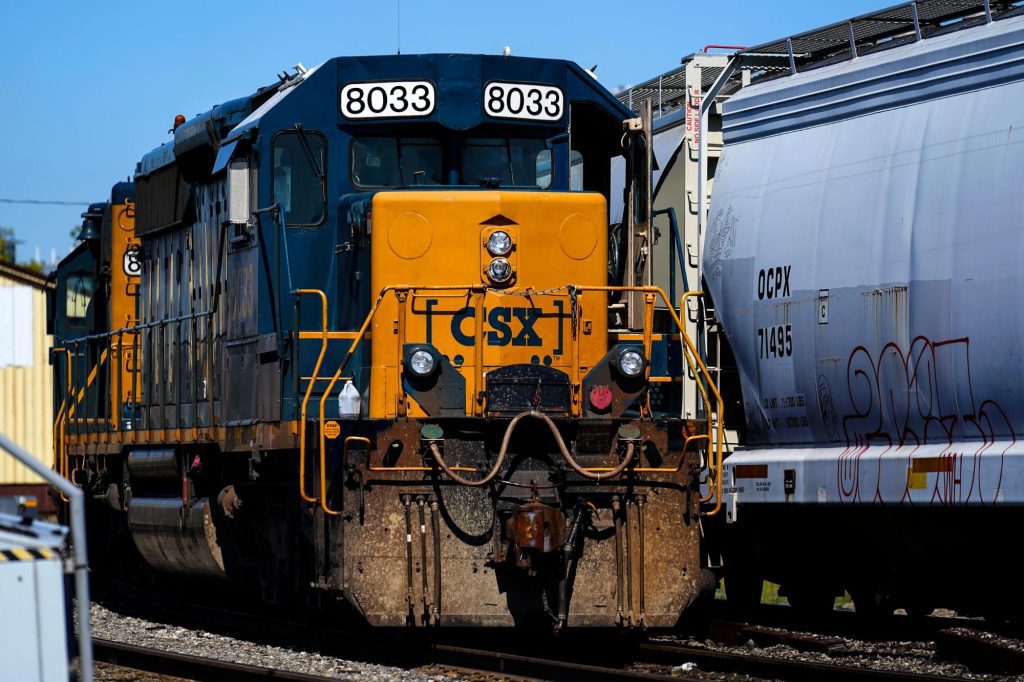By JOSH FUNK (AP Business Writer)
A new federal rule finalized on Tuesday mandates major freight railroads to maintain two-person crews on most routes.
On Tuesday morning, the Transportation Department's Federal Railroad Administration released the details of the rule after working on it for the past two years.
Railroad safety has been under intense scrutiny since the fiery February 2023 derailment in eastern Ohio. However, apart from steps the railroads pledged to take themselves and the agreements they made to provide paid sick time to nearly all workers, few significant changes have been implemented. These changes include adding hundreds more trackside detectors and adjusting how they respond to alerts from them. A railroad safety bill proposed in response to the derailment has stalled in Congress.
For about 30 years, major railroads have had labor agreements requiring two-person crews, and rail unions have long opposed one-person crews due to safety and job concerns. The unions argue that conductors play a crucial role in operating the train, keeping engineers alert, and serving as first responders in case of problems or crashes. However, many short-line railroads already operate with one-person crews without issues.
Eddie Hall, the president of the Brotherhood of Locomotive Engineers and Trainmen union, commended the FRA for fulfilling Biden's promise to preserve two-person crews. He emphasized the importance of having two people in the cab of a locomotive, especially with the increasing reliance on longer trains that routinely stretch for miles.
Transportation Secretary Pete Buttigieg stated, “Common sense tells us that large freight trains, some of which can be over three miles long, should have at least two crew members on board — and now there’s a federal regulation in place to ensure trains are safely staffed.”
Railroads have requested the ability to operate trains with only one person and transfer conductors to ground-based jobs in areas where automatic braking systems have been installed. This has been a major issue in industry contract negotiations for years, but the railroads abandoned the proposal as the 2022 negotiations approached the brink of a strike due to workers’ quality-of-life concerns.
The railroads argue that the size of train crews should be determined through contract talks, not by regulators or lawmakers. They claim there isn't enough data to prove that two-person crews are safer. The norm on major railroads is two-person crews, and current safety statistics reflect that reality. The industry pointed out that the FRA abandoned a similar rule during the Trump administration, citing insufficient evidence to support it.
Ian Jefferies, president and CEO of the Association of American Railroads trade group, criticized the FRA for enforcing a regulation that lacks a proven connection to rail safety. He added, “Instead of prioritizing data-backed solutions to build a safer future for rail, FRA is looking to the past and upending the collective bargaining process.”
Union Pacific attempted last year to assess how quickly a conductor in a truck could react to issues on a train compared to the conductor on the locomotive, but the railroad never started that pilot program. The plan would have kept two people in control of its trains during the test.
The derailment in East Palestine, Ohio, brought national attention to rail safety because of the disastrous results of the hazardous chemicals that spilled and caught fire in the crash, leading to the evacuation of thousands of people and leaving them with ongoing health concerns.
However, investigators have not indicated any wrongdoing by the crew on that train. It actually had three people on board including a trainee. Instead, the National Transportation Safety Board has stated that the derailment was likely caused by an overheating wheel bearing on one of the railcars that was not detected in time by trackside sensors.
U.S. Sen. Sherrod Brown, an Ohio Democrat, emphasized the importance of passing the rail safety bill he co-sponsored with several Republicans to ensure that future administrations could not eliminate the crew-size rule and to implement other significant improvements, including setting standards for trackside detectors and railcar inspections. Brown stated that he wants to ensure that no community ever has to endure a situation like East Palestine did.
However, the most severe railroad disaster in recent history involved a one-man crew. In 2013, the brakes failed on a train parked in the hills above the Canadian town of Lac Megantic. The train rolled downhill into the town and derailed, resulting in the deaths of 47 people and causing millions of dollars in damage.
Another fiery derailment outside Casselton, North Dakota, in 2013 illustrated the benefit of having a conductor on the train. The conductor assisted in separating undamaged tank cars filled with crude oil from the rest of the train so they could be removed from the fire.
At least 11 states have already authorized regulations requiring two-person crews because officials are concerned that losing a crew member would make railroads riskier and compromise the response to any rail disaster, as a conductor would not be available to assist immediately. States that are frustrated with the federal government's reluctance to implement new regulations on railroads have also attempted to impose restrictions on train length and blocked crossings.
The industry often challenges the state rules in court, although it is not clear if the railroads will resort to that strategy with this new federal rule. The railroads typically argue in their state lawsuits that the federal government should be the sole regulator of the industry to ensure a uniform set of rules, and they would not be able to make that argument in challenging the federal rule.









